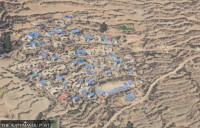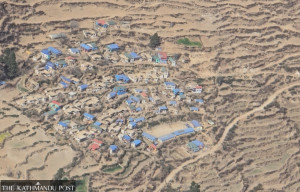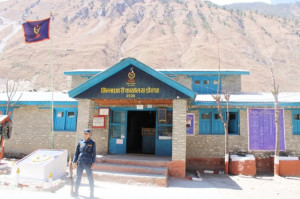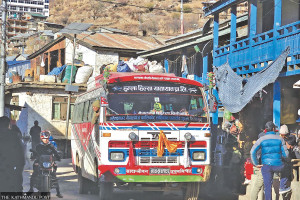Karnali Province
Mugu villages still rely on pine torches to light up homes
Of the total 9,600 households in the remote district, only about 4,000 in the district headquarters and its vicinity have electricity.
Raj Bahadur Shahi
Lakshiram Budha and his family of five light up their house using pinewood torches. Their village, Sobhagaun, is yet to be connected with electricity.
Although some households in the village have installed solar panels, families like that of Lakshiram do not have the means to afford solar power.
“Some well-to-do families in the village use solar panels but we have been making do with pinewood torches,” said Lakshiram, aged 69. “When we look towards Gamgadhi, the district headquarters, we see bright lights. We wonder when our village will light up like that.”
An asthma patient for the past two decades, Lakshiram says his condition has worsened because of the smoke-filled room he has to sleep in at night. “My asthma has got worse; my eyes tear up from the smoke from the pine torch. I always worry about my family’s health.”
As per the national census 2021, there are 9,600 households in Mugu. Among them, around 5,000 households are still deprived of electricity. Only about 4,000 households in the district headquarters and its vicinity have electricity and other alternative sources of energy like solar power. Nearly 1,000 households in Chhayanathrara Municipality Ward 2 where Sobhagaun is are yet to be connected with electricity.
Gamgadh Hydropower Project, with an installed capacity of 400kW, powers around 1,600 households out of the total 2,546 households in Chhayanathrara Municipality.
Sobhagaun, Rowa, Tallekh, Ghattalekh, Salim, Ryangkati, Lumsa, Balchaur, Kampha, Bam and Murma villages do not have electricity.
Lakshiram’s neighbour Kummalal Budha, 45, said he walks for half an hour to reach Gamgadhi to charge his mobile phone.
“I don’t think I will see Sobhagaun light up in my lifetime,” said Kummalal. “Sobhagaun has a total of 165 households and a majority of us are suffering from a lack of electricity.”
Two years ago, the federal government decided to install solar plants to generate 400kW of electricity in Gamgadhi, but the project is yet to gather momentum.
“Efforts are on to invite tender bidding for the solar plant project within a few weeks,” said Sajan Bahadur Aidi, distribution chief of the Gamgadh Hydropower Project. According to him, the hydropower project is generally disrupted for almost three months a year due to floods or landslides during the monsoons.
Khatyad Rural Municipality has a total of 3,651 households and all of them have gone back to using traditional lamps and pine torches to light up their homes after floods and landslides triggered by unseasonal rains in October last year damaged 15 mini and micro hydropower projects in the area.
Sarita Rokaya, the vice-chair of Khatyad Rural Municipality, says the repair and reconstruction work on the hydropower projects have been on hold owing to a lack of budget. “At least Rs100 million is required to repair and restore the damaged power projects. The local government cannot manage such a huge budget alone and the provincial and federal governments are indifferent to the issue,” she said.
Kamal Sharma, a local teacher in Khatyad, says the disruption in electricity supply has affected small business owners and students the most. “Schools haven’t been able to run practical classes for computer lessons. We have not been able to finish the coursework and this has affected the students’ performance,” he said.
The situation of Karmarong and Soru rural municipalities is not different. Soru Rural Municipality had planned to enhance the production of the Nerkhola Hydropower Project and connect more households to the electricity network, but the plan failed to take off due to the lack of budget. Dharma Bahadur Shahi, the chairman of the rural municipality, said, “Around 75 percent of elderly people in Soru live with various health problems, but the ones who are the most affected are asthma patients. Use of pine torches as a substitute for electric lamps has worsened their health conditions.”
Mugu, a remote district in Karnali Province, is yet to be connected to the national grid. The district depends on mini and micro-hydro power projects for the electricity supply to most villages.
Kul Man Ghising, managing director of the Nepal Electricity Authority, visited Mugu and Humla in October last year to study the prospects of power supply in the region. He had expressed his commitment to expanding the electricity transmission line to Gamgadhi by the end of the current fiscal year. But there has been no update on the future of the power projects in the area.
According to a report of the national census made public recently, around 7.8 percent of households in Nepal do not have access to electricity as a primary source of lighting.




 6.73°C Kathmandu
6.73°C Kathmandu.jpg)















